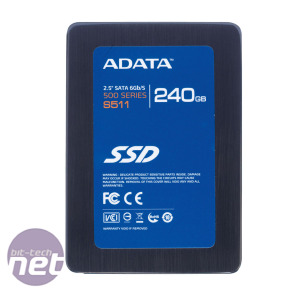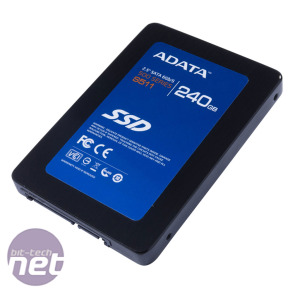
Performance Analysis
The S511 performed similarly to the Vertex 3 240GB, and even fared well in AS-SSD’s incompressible data benchmark. Its sequential read speed of 517MB/sec is almost identical to that of the Vertex 3 240GB, with the sequential write speed of 297MB/sec matching the Vertex 3’s original review speed.Random performance in AS-SSD was also good, with a 4KB single-queue-depth random read speed of 21MB/sec and a 4KB single-queue-depth random write speed of 110MB/sec. The latter speed is 10MB/sec faster than the Vertex 3, while the former speed is 3MB/sec slower. In real-world use there’s no noticeable difference, however. Moving to 4KB 64-queue-depth random performance, the S511 performed brilliantly, with a random read speed of 208MB/sec and a write speed of 234MB/sec - the best result we’ve seen from any drive in this test.
When handling the compressible data of the ATTO disk benchmark, the S511 again performed well, achieving a 4KB sequential write speed of 255MB/sec; the 4KB sequential read speed of 164MB/sec was a little slower than the Vertex 3 managed in the same test, however. With larger 1,024KB sequential reads and writes, the S511 hit its top speed, managing a read speed of 539MB/sec and a write speed of 516MB/sec. These results are within a trivial 1 per cent of the Vertex 3 scores.
However, like the Vertex 3, the S511 suffered from performance degradation after heavy use, most notably in its incompressible sequential write performance in AS-SSD, which dropped from 297MB/sec to 245MB/sec. This is standard for SandForce 2281-based SSDs, as the NAND becomes full and needs to be reused. Moreover, the results still mean that the S511 is a very quick SSD. This was the only area in which performance significantly dropped following heavy use, and with TRIM support and on-board garbage collection algorithms, we're confident the drive will retain much of its performance over time.
Conclusion
With so many SSD makers opting for the SandForce 2281 controller, manufacturers will inevitably struggle to differentiate their products from others. The ADATA S511 240GB’s approach seems to be the most sensible: it matches the SandForce 2281 drive controller with affordable yet fast synchronous 25nm NAND, and drives down the price without compromising on performance.The result is an SSD that’s just as fast as OCZ’s brilliant Vertex 3 240GB, but a healthy £41 cheaper. However, with its latest firmware, the Crucial M4 series of drives now perform very similarly to the SandForce-based competition, and take some of the sheen off of the S511's cut price. The M4 256GB is £273; £60 cheaper, and just as fast right across the board (barring the compressible data of ATTO), while also offering a higher formatted capacity.
Another concern with this drive is how quickly ADATA will release firmware updates once SandForce has created them. OCZ has an established heritage and is SandForce’s preferred partner, while its excellent OCZ Toolbox software is a pain free way to deploy updates; this is something Adata lacks, and while it has deployed firmware updates in the past, it's unlikely to do so with the regularity and ease of OCZ.
However, as SSD technology has matured over the past two years, firmware updates are becoming less important; we’ve encountered no issues with any of our SandForce 2281-based SSDs, regardless of firmware version. As such, the £40 saving sees the S511 replace the Vertex 3 as our SandForce-based SSD of choice, but the M4's latest firmware and much lower price mean that Crucial's drives are the ones to buy.
-
Value18 / 35
-
Features11 / 15
-
Speed47 / 50


MSI MPG Velox 100R Chassis Review
October 14 2021 | 15:04










Want to comment? Please log in.